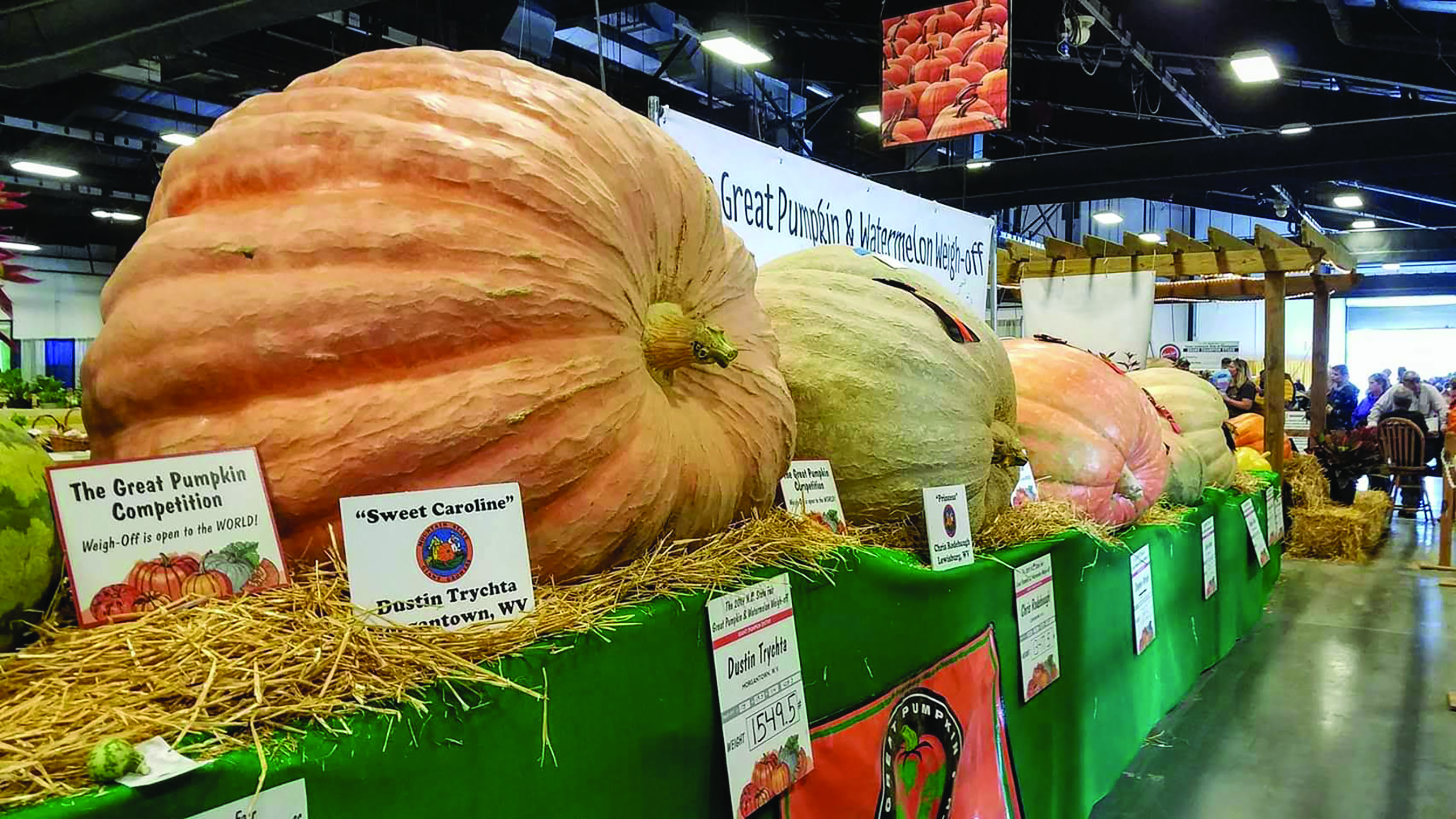“When the frost is on the punkin and the fodder’s in the shock.” ~James Whitcomb Riley
The season of autumn is upon us and with that comes the harvest-time for produce such as apples, beets, radishes, turnips, Indian corn and pumpkins which grew over the summer. Fall can bring back some spring favorites in the garden, too. We can once again benefit from cold season vegetables such as kale, lettuce, collards, Brussels sprouts and carrots that are planted in late summer to early fall and thrive when temperatures are below 70°F.
North Carolina is a great place to grow a large variety of fresh produce, including pumpkins which are ready to harvest in October. Pumpkins take about 85 to 120 days to mature, depending on the type, so they are planted about three months before, in June or July. Pumpkins like full sun with a little shade, and need plenty of space for their vines to spread out.
What do you get when you drop a pumpkin? SQUASH!
Did you know that pumpkins are a type of gourd and related to squash? Squash, pumpkins and gourds belong to the Cucurbitaceae family, which are chiefly herbaceous tendril-bearing vines of almost 1,000 species, including winter and summer squashes, cucumbers, watermelon, honeydew, and more—all of which are considered fruits! Pumpkins, in fact, are a kind of berry since they form from a flowering plant and produce fleshy fruit containing seeds.
Pumpkins and squash are believed to have originated in the ancient Americas. They were a crooked neck variety which stored well. Archeologists have determined that variations of squash and pumpkins were historically cultivated along river and creek banks along with sunflowers and beans. It is said that Christopher Columbus carried pumpkin seeds back with him to Europe, where they were used to feed pigs, but not as a human food source.
The word “pumpkin” originates from the Greek word “pepon,” which means “large melon.” It evolved to “pompon” in French and “pumpion” in Britain, and was later changed by American colonists to “pumpkin,” the name we use today.
There are over 150 separate species of pumpkin plants and many hundreds of varieties of every shape, color and size imaginable. For example, there’s the Big Moon, Kakai, Cinderella (for making magical coaches?), Casper, Blue Lakota, Blaze, Munchkin, Warty Goblin, Small Sugar (great for pie-making!), and the good old Connecticut field pumpkin, which is mostly used for Halloween decorations and as animal feed.
Native Americans introduced pumpkins and squash to the Pilgrims.
In some indigenous cultures, they would plant squash or pumpkin with corn and beans. Known as “the three sisters,” these crops thrive when planted together. Corn serves as a natural trellis for the beans to grow on. The beans’ roots set nitrogen in the soil to nourish the corn, while the bean vines help to stabilize the corn stalks on windy days. The squash plants shelter the shallow roots of the corn and shade the ground to discourage weeds and preserve moisture.
According to the University of Illinois Extension’s pumpkin history webpage: “Native Americans dried strips of pumpkin and wove them into mats. They also roasted long strips of pumpkin on the open fire and ate them.” Indigenous peoples also dried the shells and used them as bowls and containers in which they stored grain, beans and seeds. The origin of pumpkin pie is said to have occurred when “colonists sliced off the pumpkin top, removed the seeds, and filled the insides with milk, spices and honey. The pumpkin was then baked in hot ashes.”
Pumpkins were an important food source for the Pilgrims, as they stored well, which meant they would have a nutritious food source during the winter months. It is documented that pumpkins were served at the second Thanksgiving celebration. Without pumpkins, many of the early settlers might have died from starvation. The following poem from 1633 is a testament to the Pilgrims’ dependence upon pumpkins for food:
“For pottage and puddings and custards and pies
Our pumpkins and parsnips are common supplies,
We have pumpkins at morning and pumpkins at noon,
If it were not for pumpkins we should be undoon.”
The roasted flesh of pumpkin is quite nutritious! According to the U.S. Department of Agriculture, 1 cup of cooked pumpkin, without salt, contains: 1.76 g of protein, 2.7 g of fiber, 49 calories, 0.17 g of fat, 0 g of cholesterol, and 12 g of carbohydrate. Pumpkin provides a range of essential vitamins and minerals, including vitamins A, B-6, C and E; along with riboflavin, potassium, copper, manganese, thiamin, folate, pantothenic acid, niacin, iron, magnesium and phosphorus. Pumpkins are also a fantastic source of fiber.
Don’t throw away the pumpkin seeds from your Halloween pumpkin! The seeds are the beginning of next year’s pumpkins, but they also make a delicious and nutritious snack. If they’re properly toasted and are small to medium sized, they are wonderfully crunchy and easy to eat. A pumpkin has hundreds of seeds, on average about 500 of them!
To bake pumpkin seeds, first rinse the mass of seeds and strings under cool water—the seeds should separate easily. Season them with salt or spices such as cinnamon, nutmeg, cloves, ginger, cumin and chili. Then lightly grease a sheet pan with olive oil. Evenly spread the seeds on the pan. Bake them at 400°F for about 12 to 15 minutes. Watch them carefully—they’re done when they turn light brown in color. Any seeds, pumpkin or otherwise, will store best if kept cold and dry, such as in the refrigerator.
Pumpkins are a great superfood but they’re also great for seasonal decorations.
Ghoulish pumpkin faces illuminated by candles are a popular part of the Halloween tradition and have been for centuries. The practice of decorating “jack-o’-lanterns” originated in Ireland as All Hallow’s Eve decorations, where large turnips and potatoes (or even rutabagas, parsnips and beets) were usually carved. Embers or lumps of coal were placed inside for light and were thought to drive off evil spirits. Irish immigrants brought the tradition to America, home of the pumpkin (which they discovered was better for carving).
The term “jack-o’-lantern” comes from an Irish folktale about a man named Stingy Jack.
The legend goes something like this: Stingy Jack invited the Devil to have a drink with him but didn’t want to pay for it, so he convinced the Devil to turn himself into a coin that Jack could use to buy their drinks. Jack kept the money and put it into his pocket next to a silver cross, which prevented the Devil from changing back. The Devil was eventually freed, under the condition that he would not bother Jack for one year. Year after year, Jack again tricked the Devil in various ways. But when Jack died, God would not allow him into heaven and the Devil would not allow him into hell. Instead, Jack was sent off into the night with only a burning coal to light his way. Jack put the coal in a carved-out turnip and has been roaming ever since. The Irish began to refer to this ghostly figure as “Jack of the Lantern.”
Pumpkins feature prominently in other Halloween tales as well, such as the “Legend of Sleepy Hollow,” which is a colonial-America story which came about after the Battle of White Plains in New York, fought on October 28, 1776, as part of the American Revolutionary War. Traditional folklore holds that the Horseman was a Hessian trooper killed in this battle. He was decapitated by an American cannonball and the shattered remains of his head were left on the battlefield while his body was buried in a nearby churchyard. He haunts as a malevolent ghost, furiously seeking his lost head.
“Oh Jack! Oh Jack! Let me carve my protection, Shine your fire outwards, Evil rejection and reflection.” (This quote is from archangeloracle.com.) Perhaps it’s a good precaution to carve a jack-o’-lantern or to do so just for decorative purposes. Carving jack-o’-lanterns has become an art in itself and a true icon of Halloween. Intricate designs (both scary and funny) are found in many homes and both candles and electric light now illuminate the inside of the lanterns.
There are lots of tips online as to how to carve your own jack-o’-lantern.
Design patterns are also available (which you can tape to the outside of your pumpkin while carving). Farmers markets and roadside stands are great places to pick up a local pumpkin freshly harvested from the field. Larger pumpkins (plumpkins?) are easier to carve. Avoid pumpkins with mold or bruising as they go bad faster. Dirt can be washed off with warm soapy water.
Carving begins with cutting off the top to create a lid, which should be done at a 45-degree angle so the lid has a place to rest. Or you could cut a hole in the bottom of the pumpkin. Once a hole is made, the next step is to scrape out the insides using a large spoon or ice cream scooper. (Be sure to keep those tasty seeds!) It is helpful to soak the pumpkin for an hour or two in bleach water (use 1 teaspoon bleach to 1 gallon of water). This makes the jack o’ lantern last longer. To prevent shriveling, rub the interior of the pumpkin with petroleum jelly.
Finally, it’s time to get creative! It is always fun to create your own jack-o’-lantern pattern—just draw it on your pumpkin with a marker and begin carving. It’s helpful to poke holes along the pattern lines so they can be easily seen and are ready to be carved along. Use a serrated knife or tools that are designed specifically for pumpkin carving—still, be careful! (Painting pumpkins or putting stickers on them are good alternatives for little kids.) But know that you can mend a broken jack o’ lantern by using a pumpkin patch (ha, ha, joking).
When you’ve finished carving, it is time to place your jack-o’-lantern outside, light the candle, and watch it glow!
“There is magic in the night when pumpkins glow by moonlight.” ~Unknown








